When you need to pull info from websites, you'll pretty quickly come across the term “web scraping”. And right after that, you'll run into a whole bunch of tools and services that all want to help you do it.
With so many options out there, it's not always easy to figure out which one fits your needs best. That's what we're here for.
In this listicle, we'll take a look at some of the most useful web scraping tools and software in 2025 — both paid and open-source (Including AI Web Scraping Tools) — and break down what they offer and how you might use them.
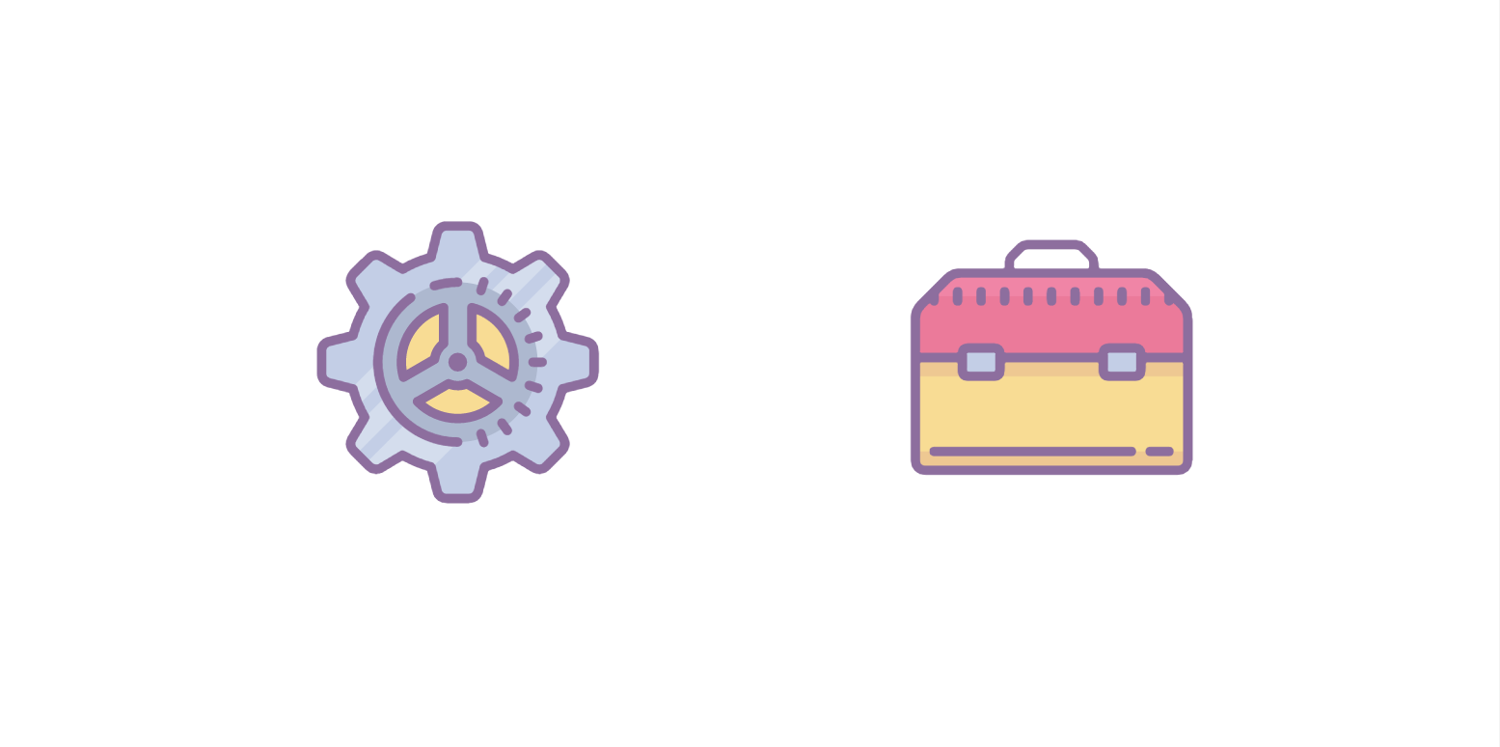
The Best Tools & Software For Web Scraping & Data Extraction
SaaS Scrapers
Desktop Scraper Applications
No-Code Browser Extension Scrapers
DIY Open Source Scrapers
Crawling Frameworks
HTML Parsers
Headless Browsers
Stealth Headless Browsers
AI Web Scraping Tools
Introduction to Web Scraping
Web scraping is all about collecting content from websites in an automated way. It can be as simple as grabbing headlines from a blog or as complex as crawling thousands of product pages across multiple online stores.
Scrapers come in all shapes and sizes, from simple scripts to full-on platforms. What exactly gets scraped depends a lot on the use case — and there are a lot of them.
One of the most common examples? Search engines. They're basically giant scrapers, constantly crawling the web to find new and updated content to include in their search index.
Other popular use cases include:
- E-commerce – comparing prices and tracking product availability across different online stores
- Finance – keeping an eye on stock prices, crypto trends, or commodity performance
- Jobs – collecting open positions from company websites and job boards
Whether you're tracking competitors, building a dataset, or just trying to stay updated, web scraping is a super useful tool — and it's more accessible than ever in 2025.
🤖 Get started Scraping by learning from practical examples in our guide on What is Web Scraping & How to Scrape Any Website
How To Choose A Tool For Web Scraping?
Many of us like to play Darts 🎯, but picking your scraping platform shouldn't be a random throw at the board, right?
So before jumping in headfirst, it's worth setting a few key parameters for your scraping project. That'll help narrow down the list of tools that actually make sense for your needs.
What to consider when scraping the web?
- Scraping Intervals – how often do you need to extract data? Is it a one-time thing? Weekly? Daily? Hourly? Maybe even non-stop?
- Data Input – what kind of data are you scraping? HTML, JSON, XML, binary formats like DOCX? Maybe media like images, audio, or video?
- Data Export – how do you want to receive the results? Raw? Pre-processed? Do you need the output in a specific format like CSV, JSON, XML, or pushed into a database or API?
- Data Volume – how much data are we talking? A few kilobytes? Gigabytes? Terabytes?
- Scraping Scope – just a few known pages, or the entire site? Will you need to crawl for new links?
- URL Discovery – how will you discover new pages? From a sitemap or central index? Do you need to crawl everything? Can you use search engines (e.g.
site:filter)? - Site Complexity – is it basic HTML or something more involved, like a Single-page application with dynamic JavaScript content?
- Scraping Obstacles – any anti-scraping defenses like CAPTCHAs, rate limits, or geo restrictions? Do you need proxy rotation or headless browsers? Check out our detailed guide on How to scrape without getting blocked
- In-House Expertise – how much work are you willing (or able) to put into building and maintaining the setup? Do you want low-code, or are you fine writing custom scripts?
- Platform Requirements – how well does the scraper fit into your current stack? Does it run on your OS? Can it connect to third-party tools or APIs you already use?
Once you've figured out what you actually need, it gets much easier to compare tools and choose the one that fits your use case best.
Alright, let's dive into the different types of web scrapers and check out some of the most popular picks in each category. Here we go! 🥳
SaaS Scrapers
SaaS scraping platforms usually offer an all-in-one service. You use their tools to define which sites you want to scrape, how the data should be processed, and how you want to receive the final results.
They typically come with a subscription fee, but that cost often includes access to a bunch of extras — like proxy management, headless browser support, and other features you'd otherwise have to set up yourself or rely on third-party tools for.
All in all, SaaS platforms tend to be the most complete package out there. If you're looking for something scalable, low-maintenance, and ready to handle the messy parts for you, this might be the way to go.
ScrapingBee
ScrapingBee gives you a lightweight REST API, plus supports libraries for popular languages like Python and JavaScript — making it easy to plug it into your scraping workflow.
Out of the box, you get:
- Data extraction via CSS selectors
- AI-powered scraping using plain English instructions (no need to mess with selectors)
- Screenshot capture of pages
- Access to Google Search API
- Support for both traditional datacenter and premium residential proxies
- Full Chrome browser engine for scraping JavaScript-heavy or SPA websites
- Structured JSON output for easy parsing and downstream processing
That last bit is huge if you're scraping complex pages and want the results clean and ready to work with.
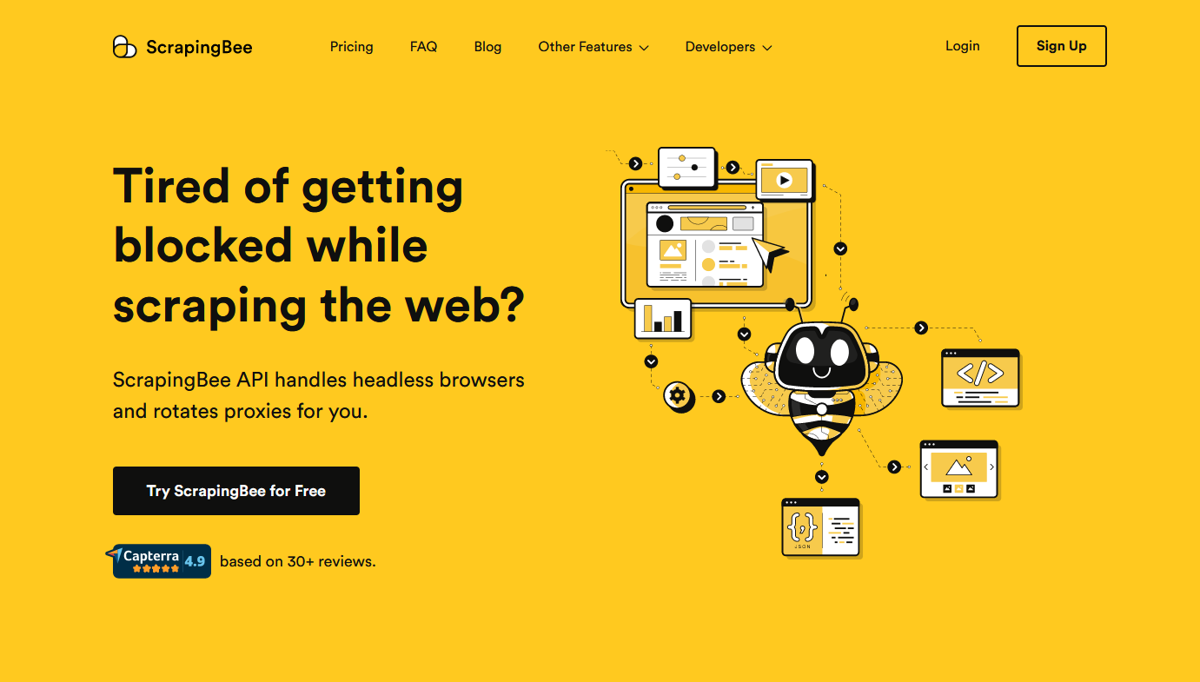
When should I use ScrapingBee?
ScrapingBee is ideal for developers and tech companies who want to manage their own scraping pipeline — but without dealing with the usual mess of proxies, CAPTCHAs, or headless browsers.
It follows a black-box approach: you send a URL (and a few parameters), and the platform handles the rest — proxy rotation, browser rendering, anti-bot bypassing — all behind the scenes.
💡 You can test ScrapingBee completely free with 1,000 API calls. Sign up at https://app.scrapingbee.com/account/register.
ScrapingBee Pros 🟢
- AI-powered scraping: write instructions in plain English. Learn more in our tutorial showing how to scrape Amazon with AI
- Supports JavaScript rendering and full SPAs
- Great at bypassing anti-bot technology like Cloudflare 🤖
- Clean, structured JSON output
- Easy integration via REST API and various programming language clients
- Solid documentation
- Great value — often cheaper than managing proxies yourself 🤑
- Handles proxy rotation, headers, and network config for you
- Easily scalable
ScrapingBee Cons 🔴
- Requires some developer knowledge (basic API use and request handling)
🔥 Here's a quick start example in a Google Colab if you want to give it a quick spin. Also check out our newly revamped API playground in your client area where you can generate examples for any major programming language, get free access here.
Diffbot
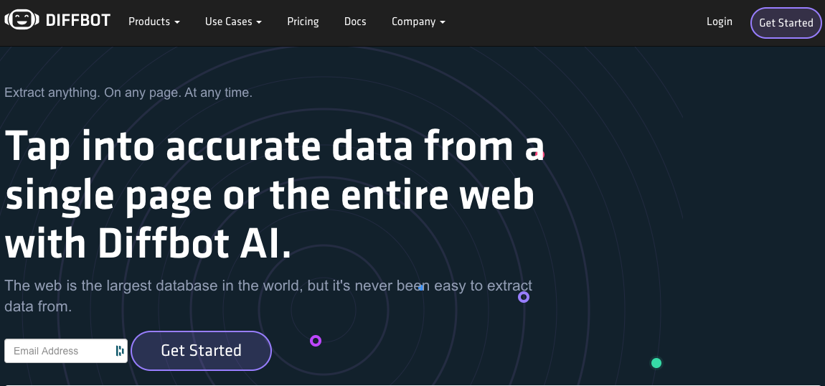
Diffbot provides a suite of web APIs that return scraped content in a clean, structured format — ready for analysis or integration.
It goes beyond simple scraping with built-in sentiment analysis and natural language processing, making it a good fit for deeper data analysis tasks. That said, it's definitely on the premium side, with plans starting at $300/month.
When should I use Diffbot?
Diffbot is best suited for developers, analysts, or tech companies that need more than just raw data. If you're working with content insights, NLP, or sentiment tracking, it's worth a look.
Diffbot Pros 🟢
- Easy to integrate into existing workflows
- Structured output format
- Built-in sentiment analysis and NLP capabilities
Diffbot Cons 🔴
- Doesn't work with every website
- Full proxy support limited to Enterprise plan
- On the expensive side
Decodo’s Web Scraping API
Decodo offers a reliable, all-in-one Web Scraping API designed to simplify data extraction from various platforms, including eCommerce sites, search engines, social media platforms, and any other target online.
With a single subscription, you get:
- Structured data extraction with pre-built scraping templates for platforms like Amazon, Google, TikTok, Airbnb, and more.
- Features such as task scheduling that help automate complex data collection tasks and adapt to changes in website structures.
- JavaScript rendering support for scraping dynamic, JavaScript-heavy websites.
- 125M+ IPs from 195+ locations under the hood for advanced IP rotation.
- Flexible output formats in HTML, JSON, or CSV, and the ability to structure the data with the AI Parser.
When should I use Decodo?
Web Scraping API is ideal for developers and businesses that require a reliable data collection solution without the hassle of managing proxies, handling CAPTCHAs, or dealing with headless browsers.
This tool simplifies data collection from various sources, covering various use cases, including market research, price monitoring, SEO analysis, and AI training.
You can test Web Scraping API with a 7-day free trial and 1K requests. Get started at https://decodo.com/scraping/.
Decodo pros
- AI-enhanced scraping that adapts to website changes and automates complex tasks.
- Supports JavaScript rendering for dynamic content extraction.
- Automatic handling of proxies, CAPTCHAs, and anti-bot mechanisms.
- Structured output in HTML, JSON, or CSV formats.
- Access to a vast proxy pool across 195+ global locations.
- Extensive documentation and API Playground for testing.
- 24/7 tech support via LiveChat.
Decodo cons
- Advanced features may require some technical knowledge.
- Some dynamic content requiring user interaction may not be fully supported.
Desktop Scraper Applications
Unlike SaaS platforms, desktop scrapers are apps you install and run locally — kind of like using a web browser, but for scraping.
They usually don't come with a subscription fee. Most are either free or available for a one-time license cost. But that also means you're in charge of everything: the hardware, the internet connection, and keeping your scraper running smoothly.
Scaling can become tricky if your project grows, since you're limited by your local setup. But for smaller or one-off scraping jobs, desktop apps can be a solid, no-fuss option.
ScreamingFrog
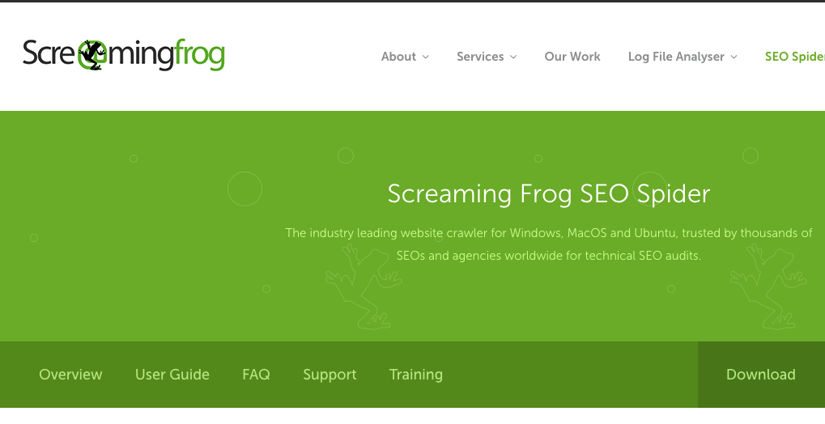
ScreamingFrog's SEO Spider is a powerful website crawler for Windows, macOS, and Linux. It's mainly built for SEO work, letting you crawl URLs, extract data, run technical audits, and analyze on-site SEO performance. It handles both small and large sites with ease and lets you view results in real-time.
Wanna see it in action? Here's a quick video overview:
When should I use ScreamingFrog?
ScreamingFrog is laser-focused on SEO, making it a top pick for SEO professionals and agencies. That said, it can still be used by anyone looking to scrape and explore site structure — no advanced setup or coding experience needed.
💡 Are you an SEO expert? Check out our guide on How to scrape Google Search Results
ScreamingFrog Pros 🟢
- Free tier available
- Easy data extraction (paid license)
- Ideal for SEO-related projects
- Real-time monitoring and analysis
- Screenshot support
- JavaScript rendering for SPA and dynamic pages
- User agent spoofing
ScreamingFrog Cons 🔴
- Yearly subscription for the full version
- Free tier is limited (mostly basic crawling)
ScrapeBox
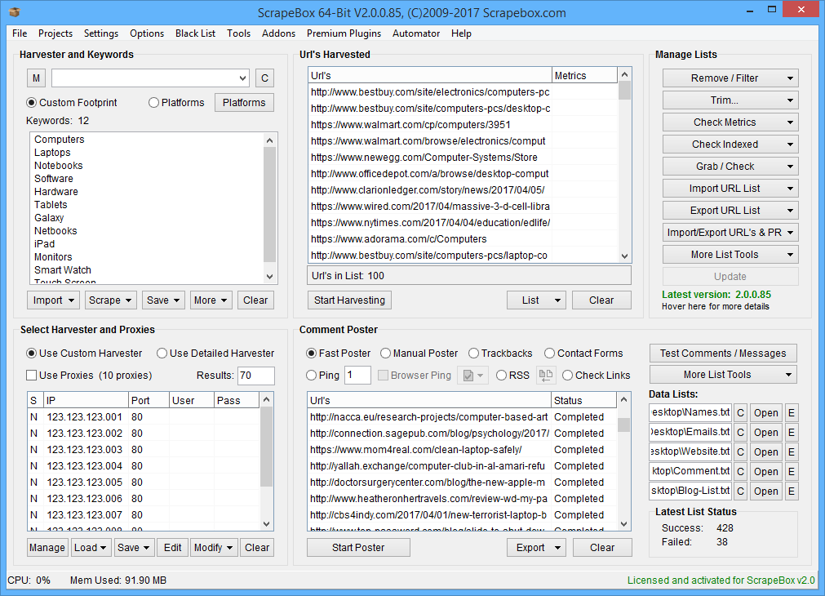
ScrapeBox is a desktop scraper for Windows and macOS with a strong SEO focus. It's often called the "Swiss Army Knife of SEO" — and for good reason.
While it's mainly used for tasks like keyword harvesting, backlink checking, and rank tracking, it also includes extra tools like YouTube scraping, email scraping, comment posting, and more — making it a pretty versatile option beyond just SEO.
When should I use ScrapeBox?
ScrapeBox is a great pick for SEO professionals, content marketers, and anyone looking to scrape data in bulk from smaller or mid-sized sites.
If you're working with smaller datasets and don't need complex proxy setups or geo-targeting, it's a solid, budget-friendly option that gives you full control from your own machine.
ScrapeBox Pros 🟢
- Runs locally — full control
- One-time license (no subscription)
- Packed with features beyond SEO
ScrapeBox Cons 🔴
- Limited scalability for large-scale scraping
- Proxy support requires extra setup and cost
ParseHub
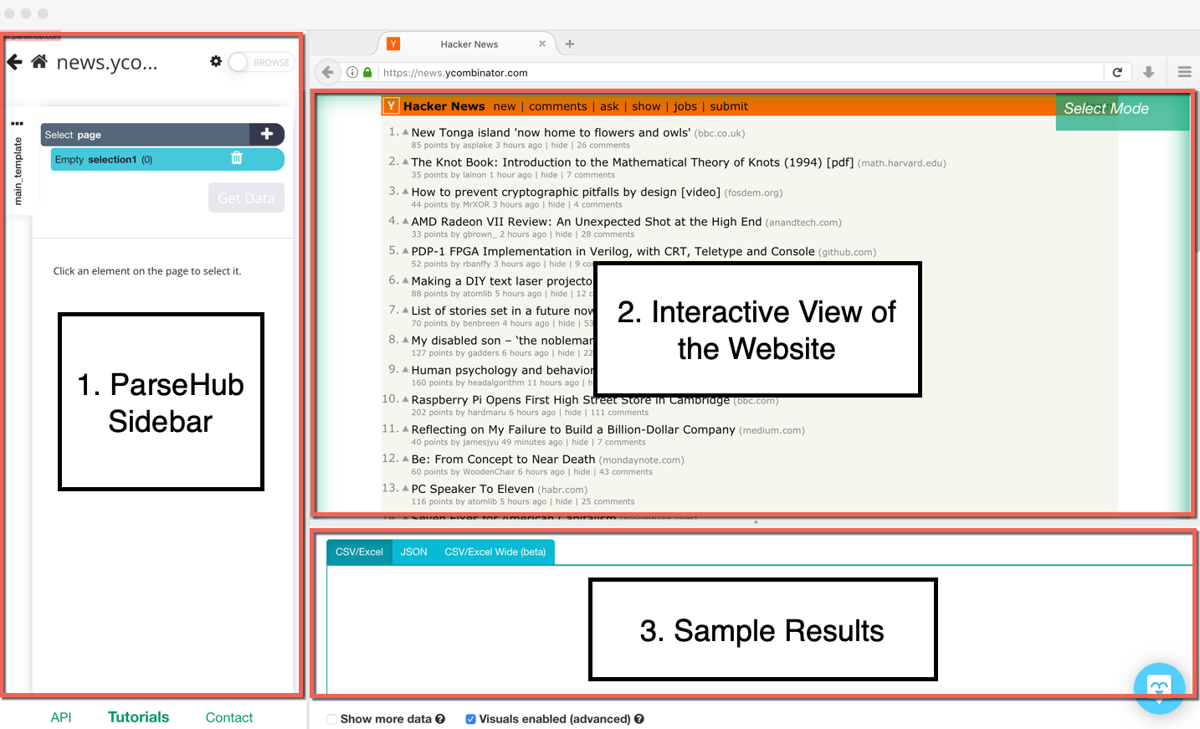
ParseHub is a desktop app (Windows, macOS, Linux) for scraping websites using a visual interface — no coding needed. You just click on the elements you want, and it figures out the rest.
It supports dynamic sites with JavaScript, AJAX, and pagination. Results can be exported as CSV, Excel, or JSON, or pulled via API.
When should I use ParseHub?
ParseHub is great for non-devs or anyone who prefers a point-and-click approach to scraping. Best suited for smaller projects where you don't need tons of speed or deep customization.
ParseHub Pros 🟢
- No coding needed
- Works with JavaScript-heavy sites
- Exports to CSV, Excel, JSON
- Cross-platform (Windows, macOS, Linux)
ParseHub Cons 🔴
- Free plan has usage limits
- Cloud features and IP rotation require paid plan
- Can be slow on big sites
- Doesn't seem to be actively developed anymore
No-Code Browser Extension Scrapers
Another popular type of web scraper is the browser extension. These scrapers run directly inside your browser (like Chrome or Firefox) and take full advantage of the browser engine — meaning they can interact with the page just like a human user.
They work with the live DOM, CSS selectors, and any JavaScript running on the page, making them super handy for scraping dynamic content without writing a single line of code.
Both Chrome and Firefox have loads of these in their extension galleries. For example, in Chrome, you can find a bunch at their store.
But instead of digging through all of them, let's take a look at three solid examples in this category.
WebScraper.io
WebScraper.io is one of the most popular browser extensions for web scraping — built specifically for Chrome. It lets you scrape websites directly from your browser, with zero need to install extra tools or write code.
You build your scraping logic using a point-and-click interface inside Chrome's dev tools, defining what elements to grab and how to navigate between pages.
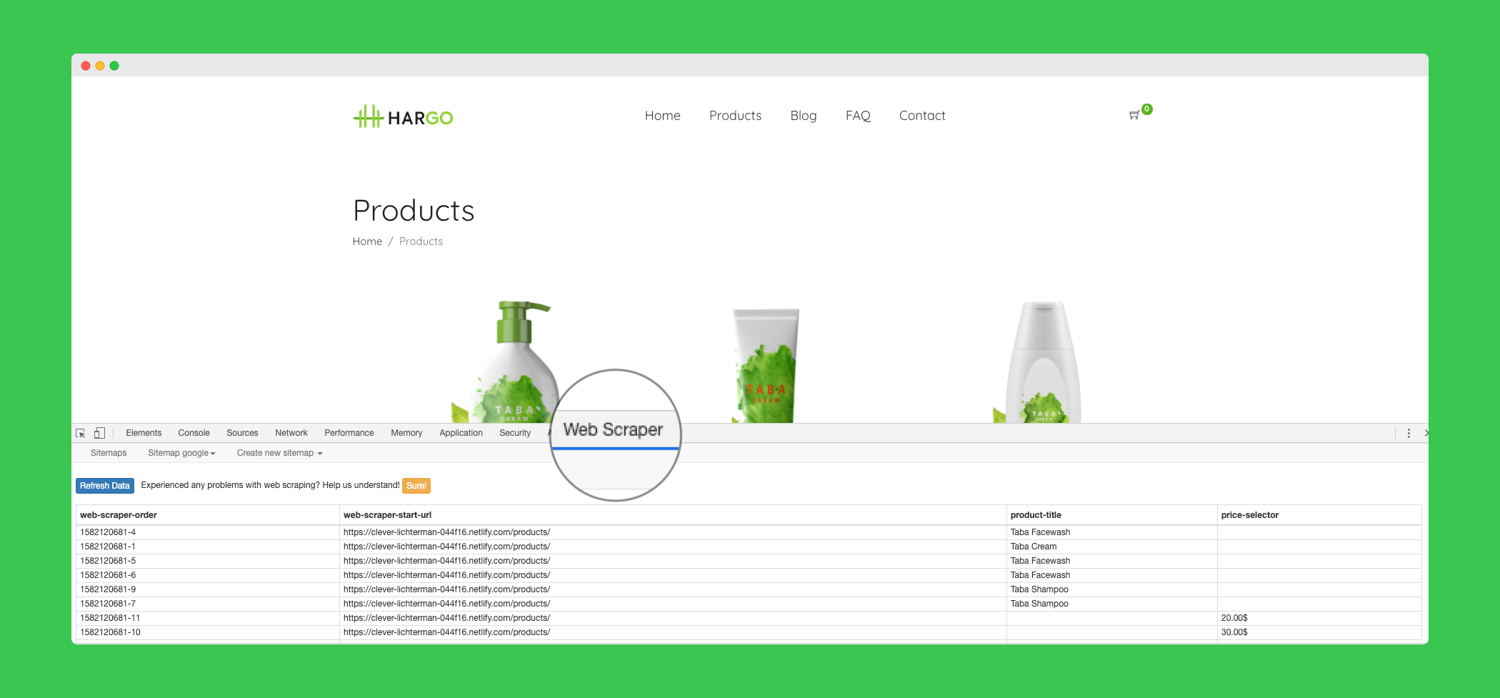
Here's a quick intro video if you want to see how it works:
They also offer a cloud-based subscription service, where you can run your scraping jobs on their servers. That's especially useful when you need proxy rotation or want to run scrapers from a specific location.
When should I use WebScraper.io?
WebScraper.io is a great pick for non-developers, marketing teams, product managers, or anyone looking to extract structured data without setting up a dev environment. Perfect for quick scraping tasks and smaller-scale jobs.
WebScraper.io Pros 🟢
- Super simple to use — point and click
- Runs directly in your browser
- No coding needed
- Optional cloud version with proxy/location support
WebScraper.io Cons 🔴
- Struggles with complex or heavily dynamic sites
- Limited flexibility compared to code-based tools
Instant Data Scraper
Instant Data Scraper is a lightweight Chrome extension by webrobots.io. Once installed, it adds a button to your browser toolbar — click it on any page, and it'll try to auto-detect and extract data for you.
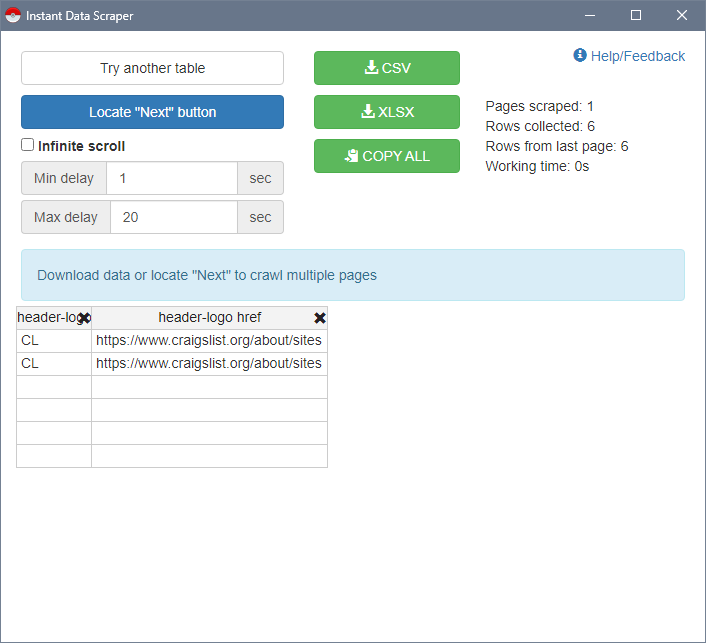
The tool is especially handy for grabbing data from tables or structured lists. You just select what you want with your mouse, and when you're done, you can export everything to a CSV or Excel file.
Check out this demo video — and enjoy the banjo while you're at it 🪕:
When should I use Instant Data Scraper?
This is a great pick for quick, no-setup scraping sessions, especially when you're dealing with structured content like tables or lists on an individual page. Ideal for one-off jobs or when you don't want to mess with settings or scraping logic.
Instant Data Scraper Pros 🟢
- Super easy to use — no config required
- Great for table-based data
- Exports to CSV or Excel in one click
- Perfect for quick, casual scraping jobs
Instant Data Scraper Cons 🔴
- Very limited scraping logic — mostly for tables
- No support for dynamic sites or multi-page navigation
DIY Open Source Scrapers (Frameworks, Libraries)
You can also build your own scraper using your favorite programming language.
There are libraries and frameworks for pretty much every language — even ones like R have solid scraping support.
Check it out: Web Scraping in R
We'll focus on Python, PHP, Ruby and JavaScript, since they're the most common in scraping. But if you're using something else, the ScrapingBee blog has guides for Groovy, Perl, Go, C++, and more.
Crawling Frameworks
When you're scraping bigger sites or need to follow lots of links, crawling frameworks are a big help.
They handle link discovery, concurrency, and structured data extraction — so you don't have to build all that yourself.
Let's take a look at some of the top tools in this space.
Scrapy
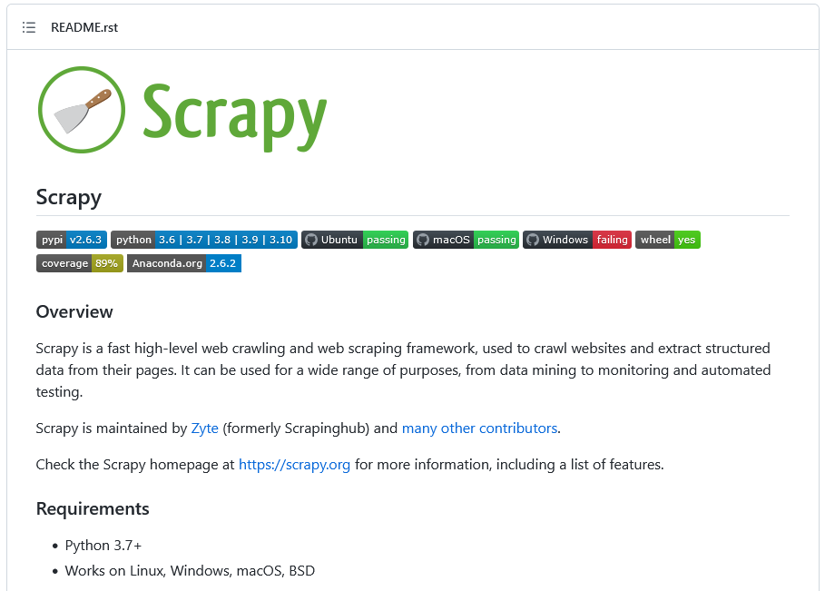
Scrapy is a powerful open-source web crawling framework written in Python. It handles requests asynchronously, which makes it fast and scalable — great for scraping large volumes of data across many sites.
💡 Find a full guide on Scrapy in our blog. Also you might be interested in using Scrapy with Playwright and How to execute JavaScript with Scrapy.
When should I use Scrapy?
Scrapy is best for developers with a Python background. It's a framework, not a plug-and-play tool — so while it handles a lot for you, you'll still need to know what you're doing.
It's ideal for large-scale scraping tasks like:
- Extracting product data from e-commerce sites
- Pulling articles from news websites
- Crawling entire domains and collecting links
Scrapy Pros 🟢
- Feature-rich and built for web scraping
- Asynchronous and scalable
- Actively maintained with great docs
Scrapy Cons 🔴
- Requires Python development experience
- JavaScript scraping needs manual setup
Crawlee
Crawlee is a Python framework that helps you build reliable, maintainable web crawlers — bundling tools like BeautifulSoup, Playwright, and proxy rotation into one structured package.
It's great for both beginners and experienced devs looking to streamline their scraping stack. Whether you're scraping with HTTP requests or need full browser automation, Crawlee makes switching between the two easy.
💡 Want a full guide? Check out our Crawlee for Python tutorial with examples.
When should I use Crawlee?
Crawlee is perfect if you want a solid middle ground between raw libraries and full scraping frameworks. It's especially useful when:
- You need to scale scraping jobs using asyncio
- You want structured, clean code with link queues and data storage built-in
- You're switching between lightweight scraping and full browser automation
Crawlee Pros 🟢
- Combines BeautifulSoup, Playwright, and proxy handling in one package
- Easy to switch between HTTP and headless browser scraping
- Built-in link queuing and data storage
- Smart proxy rotation with error detection
- Concurrency and auto-scaling with asyncio
- Available for both Python and Nodejs
Crawlee Cons 🔴
- Still relatively new — ecosystem and docs are growing
- Requires basic Python or JS and async knowledge
Honourable Mention: Common Crawl
Common Crawl isn't a scraper tool or framework in the traditional sense — but it's definitely worth a mention.
Instead of building your own scraper or using a service, Common Crawl takes a different approach: it scrapes and crawls the web in advance, then makes massive datasets publicly available for anyone to download and use — completely free.
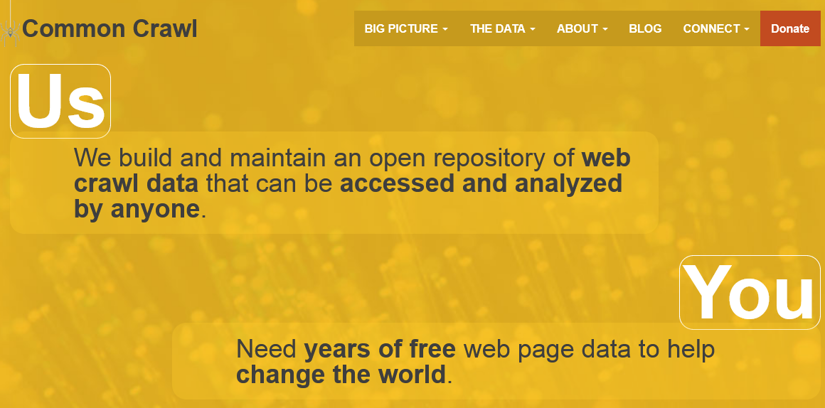
To give you a sense of scale: as of writing, their current dataset is close to 400TB. (Or about 650,000 traditional CDs, if you're into random comparisons 😉.)
When should I use Common Crawl?
Use Common Crawl if their datasets match what you're looking for. If the data they've already collected is good enough for your project, it's a hassle-free way to access large-scale web content without scraping it yourself.
Common Crawl Pros 🟢
- Huge amount of web data available for free
- No need to set up or run any scrapers
Common Crawl Cons 🔴
- You can't customize what gets scraped
- Downloading and processing the data requires solid infrastructure
💡 Want to dive deeper into scraping tech? Check out our guide to what is a headless browser and which ones are the best.
HTML Parsers
While not full scraping frameworks, HTML parsers are essential tools when building your own scrapers. They help you navigate and extract data from raw HTML — turning messy markup into something structured and usable.
These tools don't handle things like HTTP requests or crawling on their own, but when combined with other libraries, they form the backbone of many DIY scraping setups.
Let's take a look at a few popular options, starting with the classic: BeautifulSoup.
BeautifulSoup

Back in Python territory, BeautifulSoup — or BS4, as fans affectionately call it 🤩 — is a classic HTML parsing library used in countless scraping projects.
Unlike frameworks like Scrapy or Crawlee, BS4 is lightweight and focused purely on parsing. It doesn't handle crawling or HTTP requests, but it pairs well with libraries like requests or httpx.
ℹ️ Check out our BeautifulSoup tutorial for real-world examples and our full guide on Python Web Scraping
When should I use BeautifulSoup?
BS4 is perfect if you're using Python and want full control without being locked into a framework. It's simple, flexible, and great for building your own scraper logic from the ground up.
BeautifulSoup Pros 🟢
- Easy-to-use API
- Regular updates and strong community support
- Great for custom scraper setups
BeautifulSoup Cons 🔴
- Not beginner-friendly for non-developers
- Needs to be combined with other tools for full scraping workflows
Goutte
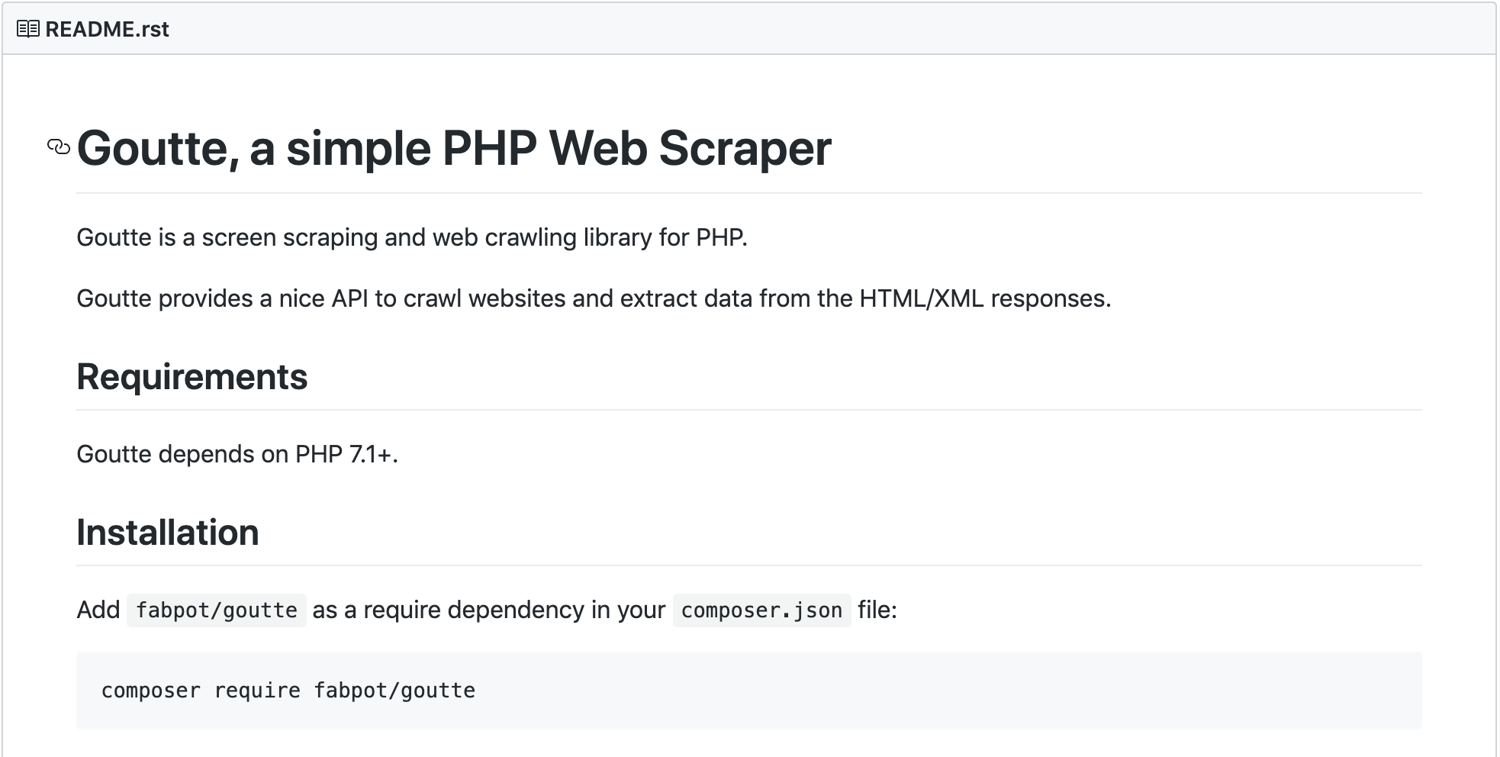
Goutte is a lightweight PHP library for web crawling and scraping. It's built on top of Symfony components and offers a clean API for extracting data from HTML and XML responses.
It works well with the popular Guzzle HTTP client, making it flexible enough for more advanced scraping setups — especially if you're already working in a PHP environment.
ℹ️ Check out our Goutte tutorial for a quickstart guide and our full guide on Web Scraping with PHP
When should I use Goutte?
If you're working in PHP and need a simple but capable scraping tool, Goutte is a solid pick. It's especially handy for integrating scraping into existing PHP projects or backend workflows.
Goutte Pros 🟢
- Open-source and free
- Clean API, easy to work with
- Integrates with Guzzle for advanced requests
Goutte Cons 🔴
- Limited to PHP projects
- Smaller ecosystem compared to Python tools like Scrapy
Cheerio.js

If you've used jQuery before, Cheerio.js will feel instantly familiar — it's basically the server-side equivalent.
Cheerio lets you parse HTML using the same CSS selector syntax from jQuery, and extract data with a simple $('') call. It's fast, lightweight, and perfect for working with static HTML in Node.js environments.
When should I use Cheerio.js?
Can be summarized in one sentence: When you need to parse HTML in a JavaScript or Node.js project. That's really it.
(Okay, technically two sentences — but you get the point. 😳)
Cheerio.js Pros 🟢
- Familiar and easy if you know jQuery
- Fast and efficient for parsing static HTML
- Full CSS selector support
Cheerio.js Cons 🔴
- Doesn't handle JavaScript-rendered content (SPAs)
- Requires experience with JavaScript and Node.js
ℹ️ Check out our full guide on Web Scraping with JavaScript
Nokogiri
Nokogiri is the go-to HTML and XML parser for Ruby. It's widely used for web scraping in Ruby projects and provides a powerful API for navigating, searching, and modifying HTML/XML documents.
It supports CSS selectors and XPath, making it flexible and efficient for extracting data from structured content.
ℹ️ Check out our full guide to web scraping with Ruby and Nokogiri
When should I use Nokogiri?
If you're working in Ruby and need to parse HTML or XML, Nokogiri is your tool. It doesn't handle HTTP requests or crawling on its own, but it pairs well with gems like httparty or open-uri.
Nokogiri Pros 🟢
- Powerful and fast HTML/XML parsing
- Supports both CSS selectors and XPath
- Well-documented and actively maintained
Nokogiri Cons 🔴
- Ruby-specific — not useful outside that ecosystem
- Requires pairing with other tools for a full scraping setup
Headless Browsers
Sometimes, traditional scrapers or HTML parsers just aren't enough — especially when dealing with JavaScript-heavy websites or Single Page Applications (SPAs). That's where headless browsers come in.
Headless browsers simulate a real browser environment without a graphical interface. They can render JavaScript, handle navigation, click buttons, and even take screenshots — all programmatically.
In this section, we'll cover some of the most popular tools for headless scraping and browser automation.
Selenium
Selenium is one of the oldest and most well-known browser automation tools out there. Originally built for testing web applications, it's also widely used for web scraping — especially when you need to simulate real user behavior across different browsers.
Selenium supports multiple programming languages (like Python, Java, and JavaScript) and can control various browsers, including Chrome, Firefox, and even Safari.
When should I use Selenium?
Use Selenium if you need cross-browser scraping or if you're already familiar with it from automated testing. It's especially handy when scraping requires interaction — like logging in, filling forms, or clicking through multi-step flows.
Selenium Pros 🟢
- Works across multiple browsers and languages
- Good for sites requiring interaction and full rendering
- Large community and tons of learning resources
Selenium Cons 🔴
- Slower and heavier than modern alternatives like Playwright
- Setup can be more complex for scraping-specific use cases
ℹ️ Selenium is a go to for anyone building their own scraper, check out the further reading to become a Selenium Web Scraping Pro:
Playwright
Playwright is a modern browser automation library developed by Microsoft. It's similar to Puppeteer, but with support for multiple browsers out of the box — including Chrome, Firefox, and Safari.
It works with several languages (Python, JavaScript, C#, and Java), making it super flexible. Playwright also handles modern web features like iframes, file uploads, downloads, and complex UI interactions — and it does all of that with excellent performance.
When should I use Playwright?
Playwright is a great choice if you need to scrape JavaScript-heavy websites or interact with dynamic UIs — especially across different browsers. It's also a solid upgrade if you've hit performance or compatibility limits with Selenium.
Playwright Pros 🟢
- Supports multiple browsers and languages
- Handles SPAs, dynamic content, and modern UI features
- Fast and reliable automation engine
Playwright Cons 🔴
- Slightly heavier setup than basic scraping tools
- Requires basic coding knowledge (Python, JS, etc.)
ℹ️ Playwright is becoming an increasingly popular framework, check out these resources to start mastering this scraping package
Puppeteer
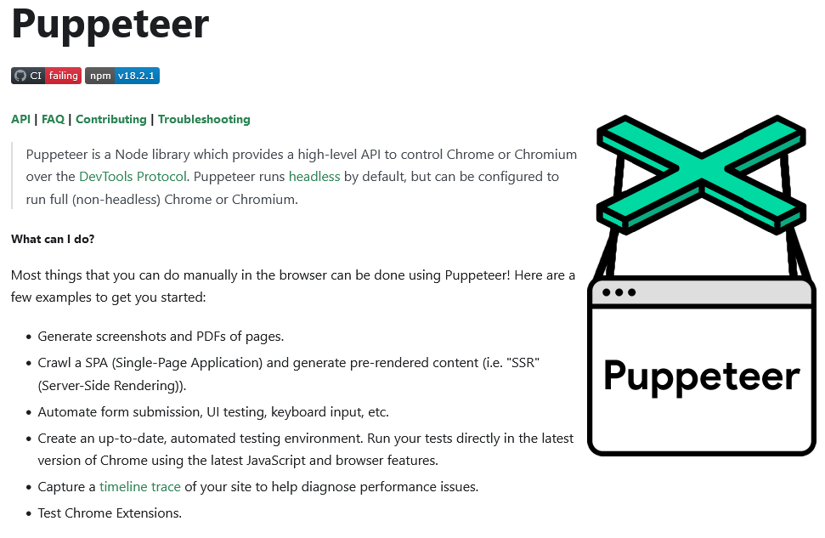
Puppeteer is a Node.js library that gives you full control over a Chrome Headless instance — basically letting you automate and interact with a real browser using JavaScript and Python.
You can use it to load SPAs, click through pages, fill forms, capture screenshots, and scrape fully rendered content — just like a human user would, but in code.
When should I use Puppeteer?
Puppeteer is perfect if you're using JavaScript and need to scrape JavaScript-heavy websites (like SPAs) where traditional parsers like Cheerio fall short. Since it runs an actual browser, it can render and interact with content that isn't available in raw HTML.
Puppeteer Pros
- Full browser control via code
- Handles JavaScript rendering and dynamic content
- Can simulate user actions (clicks, typing, etc.)
Puppeteer Cons
- Requires Chrome to be installed
- More resource-intensive than lightweight parsers
ℹ️ Check out our resources on Puppeteer:
Stealth Headless Browsers
Many websites today actively detect and block headless browsers by checking for signs that a real user isn't behind the request — like missing browser properties or unusual behavior.
That's where stealth headless browsers come in. These tools are built to mask automation fingerprints and make your scraper look more like a real human browsing the site. They tweak browser properties, spoof user agents, handle CAPTCHAs, and more.
Let's take a look at some tools and plugins that bring stealth mode to your scraping game.
🤖 Check out our article on Browser Fingerprinting tech CreepJS which we used to benchmark the stealthlyness of these headless browsers below.
Camoufox
Camoufox is a stealth-focused custom build of Firefox, built for scraping and evading anti-bot detection.
It uses low-level fingerprint spoofing (no JavaScript injection) to make headless automation harder to detect. Camoufox supports Playwright, rotates fingerprints, mimics human behavior, and strips out browser bloat for better performance.
ℹ️ Learn more about scraping with Camoufox and bypassing antibot technology in our blog.
When should I use Camoufox?
Use Camoufox when you need maximum stealth for scraping sites with heavy bot protection — especially if you're already working with Playwright.
Camoufox Pros 🟢
- Strong fingerprint spoofing
- Optimized for stealth and performance
- Works with Playwright
- Open-source
Camoufox Cons 🔴
- Requires technical setup
- Smaller ecosystem and limited docs
Undetected Chromedriver
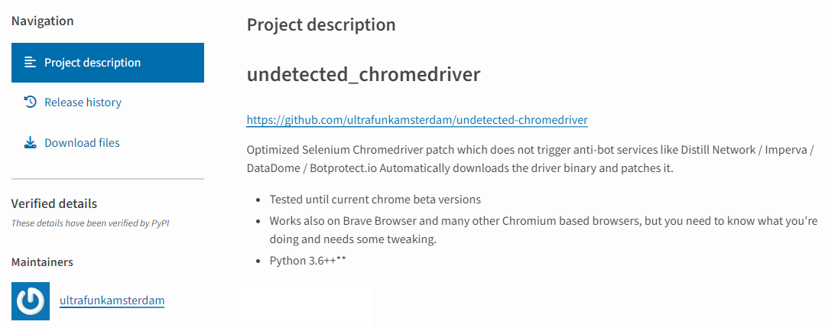
Undetected Chromedriver is a modified version of ChromeDriver designed to work with Selenium and bypass anti-bot systems like Cloudflare, Distil Networks, Imperva, and DataDome.
It helps your bot appear more like a real user by patching common fingerprinting methods used to detect automation.
ℹ️ Learn more about Undetected Chromedriver usage in our blog.
When should I use Undetected Chromedriver?
Use it when you're scraping with Selenium and running into bot protection walls. It's solid for most mid-level defenses, though it may still struggle with more advanced anti-bot setups.
Undetected Chromedriver Pros 🟢
- Bypasses many common bot detection techniques
- Integrates directly with Selenium
Undetected Chromedriver Cons 🔴
- This project is no longer actively maintained and has been succeeded by NoDriver
- Requires familiarity with Selenium and ChromeDriver
- Needs extra setup and regular maintenance
- Not foolproof against the most advanced anti-bot systems
NoDriver
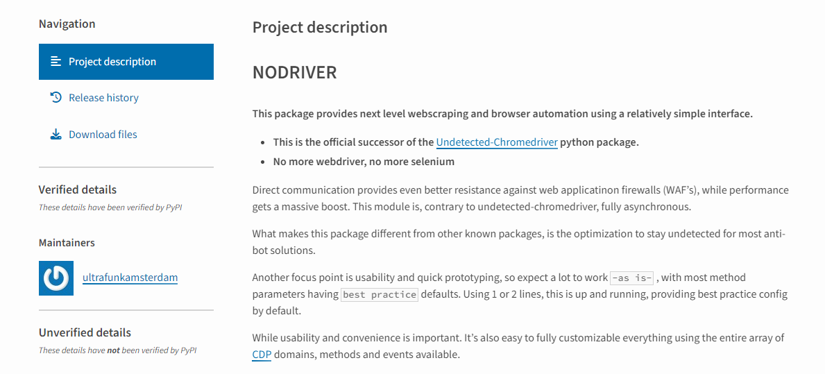
NoDriver is a fast, asynchronous tool for web automation that replaces Undetected Chromedriver. It talks directly to the browser — no webdriver binaries, no Selenium — which means less detection and better performance.
It's designed to avoid anti-bot systems like Cloudflare, hCaptcha, Perimeterx, and Imperva while keeping your scraping smooth and fast.
ℹ️ Read our detailed NoDriver tutorial in our blog.
When should I use NoDriver?
Use NoDriver when you want a lightweight, stealthy alternative to Selenium or Undetected Chromedriver. If you're familiar with Selenium in Python, you'll feel right at home — it's built as the official successor to the Undetected-Chromedriver package.
NoDriver Pros 🟢
- No Selenium, no webdrivers — pure browser control
- Fast and stealthy automation
- One-line setup and auto cleanup
- Uses a fresh profile for every run
- Open source and actively maintained
NoDriver Cons 🔴
- Can still be blocked by high-end anti-bot systems
- Smaller community and fewer learning resources
AI Web Scraping Tools
AI-powered web scrapers are a newer generation of tools that take a lot of the complexity out of scraping. Instead of writing code or building complex selectors, you can simply describe what data you want in plain English, and the tool figures out how to extract it.
These scrapers often combine natural language processing with automation engines and are especially useful for non-developers, fast prototyping, or when dealing with messy, constantly changing sites or a list of sites that have different layouts.
Let's take a look at a few standout AI scraping tools that are making the process smarter and easier.
ScrapingBee AI Web Scraping API
ScrapingBee's AI Web Scraping API lets you extract data by simply describing what you need in plain English — no selectors, no DOM digging.
It returns clean JSON and adapts to layout changes, making it great for scraping dynamic or frequently updated sites.
When should I use it?
Perfect for fast, no-code scraping of product data, contact info, reviews, and more — especially on JavaScript-heavy sites. Use when you don't want to maintain the selectors or the site's layout keeps changing.
ScrapingBee AI Web Scraping API Pros 🟢
- Natural language input
- Structured JSON output
- Handles dynamic content and layout changes
- Easily scalable
- Anti-bot protection built-in
ScrapingBee AI Web Scraping API Cons 🔴
- Costs an additional 5 credits cost on top of the regular API cost.
BrowserUse
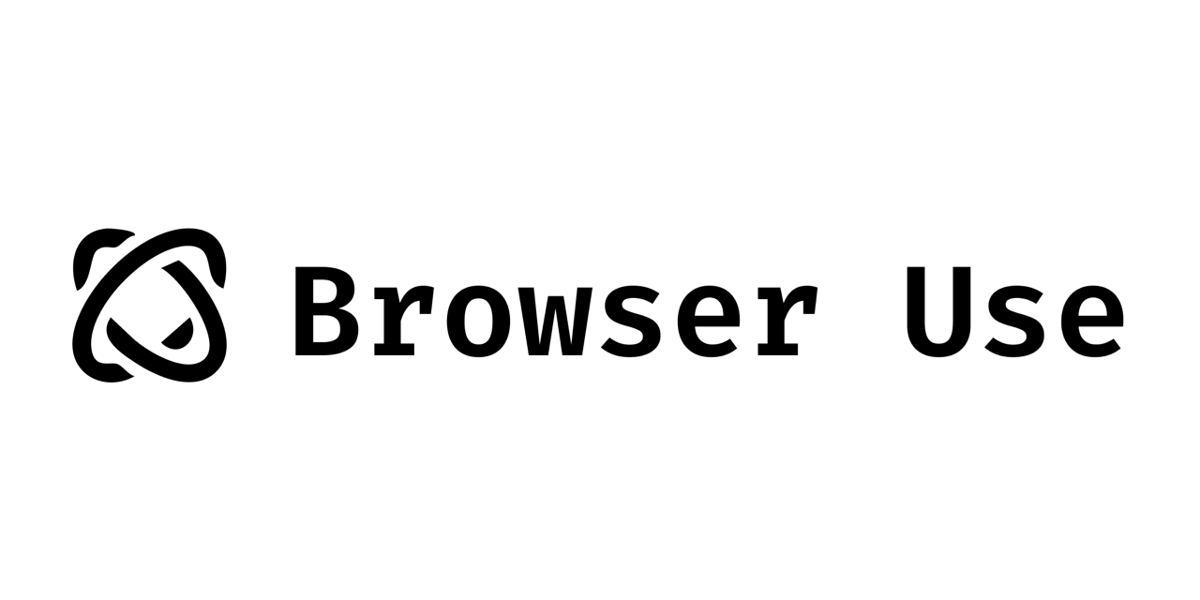
BrowserUse is an open-source Python tool that lets AI agents interact with websites using natural language. It turns web pages into structured text, so LLMs like GPT-4 or Claude can navigate, extract data, fill forms, and more — no CSS selectors needed.
It runs on top of Playwright and includes a web UI for quick testing and prototyping.
💡 Check out our BrowserUse tutorial for a full walkthrough.
When should I use BrowserUse?
Use it when you want to automate web tasks with LLMs — like scraping or form filling — using just plain language.
BrowserUse Pros 🟢
- Natural language-based scraping and automation
- Works with GPT-4, Claude, and others
- Handles complex, dynamic pages
- Open source and actively maintained
BrowserUse Cons 🔴
- Requires Python and Playwright setup
- May need prompt tuning for tricky flows
ScrapeGraphAI
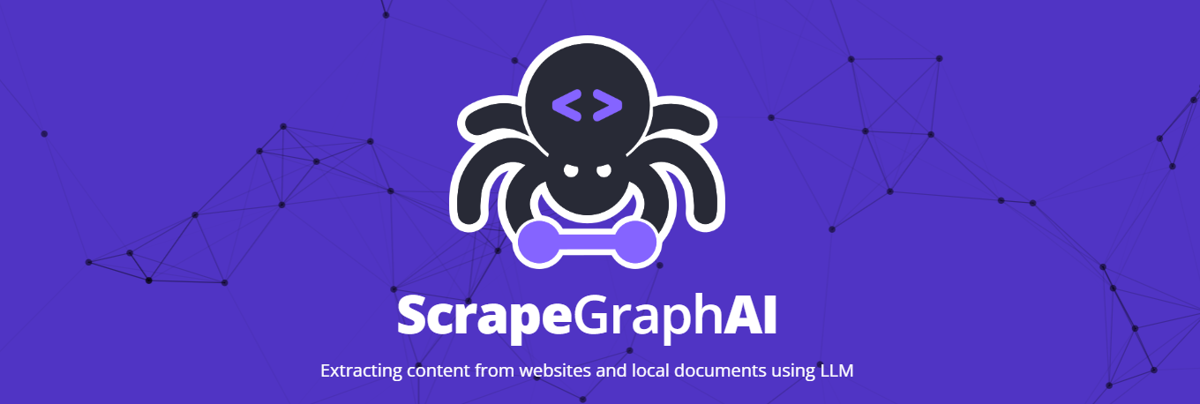
ScrapeGraphAI is an open-source Python library that combines Large Language Models (LLMs) with a graph-based approach to automate web scraping.
Just describe what you need in plain language, and it builds a custom scraping flow — no manual parsing or selectors required. It works with websites, APIs, local files, and more.
💡 Check out our ScrapeGraphAI tutorial for a full walkthrough.
When should I use ScrapeGraphAI?
Perfect for developers who want flexible, AI-driven scraping with minimal code — especially when working with mixed data sources.
ScrapeGraphAI Pros 🟢
- Natural language prompts
- Supports OpenAI, LLaMA, Mistral, and more
- Works with HTML, JSON, Markdown, and local files
- Modular graph-based architecture
- Open source and actively maintained
ScrapeGraphAI Cons 🔴
- Requires setting up LLMs and dependencies
- Slightly steeper learning curve for beginners
Summary
There are tons of web scraping tools to choose from — from small, local desktop applications to enterprise-grade platforms that can scale up to millions of requests per second.
There’s also a whole smorgasbord of free DIY scraping libraries available in almost every programming language. So if you choose to go the manual route and build your own scraper, chances are you'll find solid tooling to support your stack, although these can struggle to bypass anti-bot tech.
Whichever technology you choose, make sure to test it thoroughly before using it in production. Keep an eye on edge cases.
💡 Web Scraping without getting blocked
We have a full article dedicated to this topic, breaking down the techniques and tools you can use to avoid getting your crawler blocked. Give it a read — and feel free to share your feedback!
We hope this guide gave you a solid first overview of the different technologies available in the web scraping space, and made it a little easier to navigate the many platforms, services, and libraries out there.
If you have any questions about how to move forward with your scraping project — or how ScrapingBee can help — don't hesitate for a second to reach out to us. We're specialized in this field and always happy to help.
Happy scraping from ScrapingBee!

Kevin worked in the web scraping industry for 10 years before co-founding ScrapingBee. He is also the author of the Java Web Scraping Handbook.


